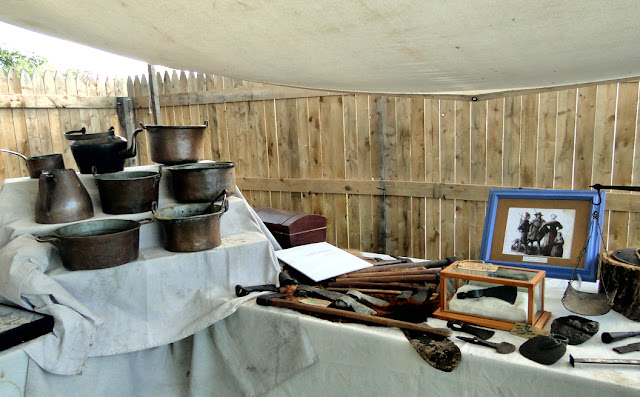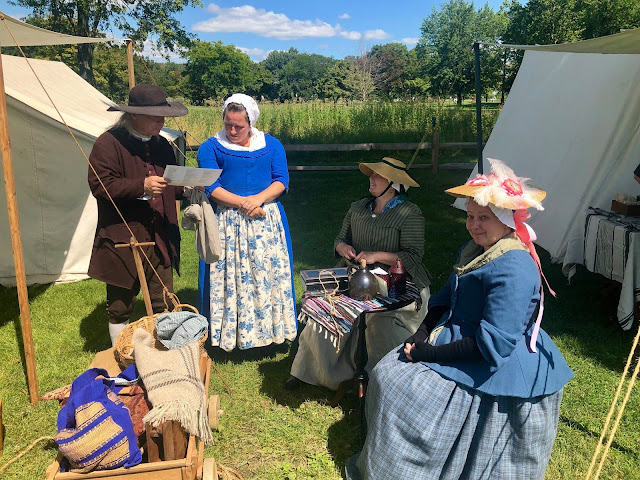~Well, it is a new event for me!~
I once wrote that the only original 18th century structures still standing in Michigan, aside from the few that were relocated here from New England to historic Greenfield Village (thus, not originals to our state), are up on Mackinac Island at the northern tip of the lower peninsula in Lake Huron.
Well, I was wrong!
Boy! Was I wrong.
The fact is, there is a pretty awesome building directly from the later 18th century less than an hour from my home:
 |
| Crossing the bridge to the past - - |
According the book Michigan Place Names, Francois Navarre was born in Ontario, Canada, right across the river from Detroit, in 1763, and would become the first permanent white settler in the area now known as Monroe in 1784. On June 3, 1785, Potawatomi Native American Indian chiefs signed a deed giving Colonel Navarre land on the south bank of the River Raisin. Navarre’s homestead was located where the present day Sawyer Homestead stands. More land was gifted to him the following year, allowing him to build a Catholic Church, and eventually bringing nearly a hundred more French settlers into the area, calling this new settlement Frenchtown. This was on the north bank of the River Raisin just a couple hundred yards northeast of the present Winchester Street Bridge, and the Natives and the newcomers, who built log cabins and the long narrow strip farms, got along well, with many inter-marrying. It was only the third permanent European-based community in Michigan. Frenchtown was renamed Monroe in 1824, for the current President at the time. Navarre is known as the "Father of Monroe" because of the settlement he began as well as his other accomplishments involving the War of 1812.
 |
You are approaching the oldest wooden structure in
The smaller building you see there is the Cookhouse, southeastern lower Michigan. which was originally built as a cabin in 1810. |
Other buildings include the Navarre-Morris 1810 cookhouse and a replica 1790’s French-Canadian style barn.
Why I was not aware of this before, I have no idea. But I can just hear my fellow Michigan history nerds: "Well, duh, Ken! Where've you been?"
Yeah...I'll take all you got to throw at me. I suppose I do have it coming. At least I can admit when I've blundered, right?
 |
| The reenactment wasn't large, but sometimes the smaller events can be every bit as good as the larger ones. It helps that the location was perfect! |
 |
| Preparing for a new day. |
 |
| Time to hunt a turkey for the day's meal. |
 |
| So for this scenario I am running a trading post, and I see a few potential customers: the military men, possibly on leave for a few days. |
 |
| Tony needed candles and was willing to pay cash, which is fine by me. The price I charged him was 3s 6d (two shillings and six pence) for 8 pounds weight. |
 |
| Of course, in hopes for another sale, I thought I'd entice the men with a nip of rum. |
 |
| Richard enjoyed it quite a bit. |
 |
Richard purchased the jug and kindly shared with his friends... |
 |
| But he saved the greater part for himself. |
As the scenery surrounding the area was historically beautiful, we did a few posed shots outdoors as well, including a couple on the banks of the River Raisin.
During the winter of 1813, as part of the War of 1812, the Battle of Frenchtown occurred near the river. British and Native American troops under the command of British General Henry Procter and Native American chiefs Roundhead, Walks in Water, and Split Log, were allied against a division of ill-trained Kentucky infantry and militia under command of General James Winchester. Cut off and surrounded and facing total slaughter, Winchester surrendered with British assurances of safety of the prisoners. The British and Potawatomi allies marched those who could walk to Detroit. But the next day, many of the severely wounded prisoners left in Frenchtown were killed by the Native American allies of the British.
The Massacre of the River Raisin became a rallying cry ("Remember the Raisin") for Americans in the war, particularly for Kentuckians. United States troops returned in the spring to drive the British from Michigan forever. The original battlefield was preserved for years as a county park in Monroe, Michigan. It has several monuments erected to the Kentucky soldiers who died there. On October 12, 2010, the land was transferred to the federal government. By Congressional authorization, it is the only National Battlefield Park designating a battlefield of the War of 1812 - the River Raisin National Battlefield Park.
But at this reenactment, we were portraying a time thirty plus years previous - a time during the Revolutionary War, and a skirmish was held.
 |
| A 1st Continental Regiment riflemen warns a tavern keeper that the Regulars have landed nearby and may be on the march in this direction. |
 |
Back to the 18th century.
If you look hard, you just might see a few Redcoats across the river...(No, there really were no redcoats there - just some photo fun) |
The fighting at this reenactment did not represent an actual occurrence in this location. However, I did find information about a smaller battle - sort of a pre-war battle - that took place in Virginia, for not all battles during the Revolutionary War were of large scale. For instance, there was the Skirmish at Kemp's Landing:
With the building tension of the growing American Revolution, there was a struggle to gain control of military supplies like muskets and gunpowder. In March 1775, Virginia's royal British Governor John Murray, Earl of Dunmore (also called just Lord Dunmore) had already raided the colonial storehouse in Williamsburg, Virginia. Lord Dunmore removed his family from the vicinity, fearing for his safety, even though there was no fighting.
 |
| The tension grew. The Patriots had accumulated a group of men and Lord Dunmore had requested military backup. |
General Thomas Gage sent a small detachment of his foot regiment, who began raiding the surrounding villages for more military supplies, hoping to bolster their stores and cripple the Patriots.
 |
Lord Dunmore had heard rumors of growing militia troops, and began scouting the area. He sent about 120 men to Kemp's Landing. Tony is with Lord Dunmore at this skirmish Tony is with Lord Dunmore at this skirmish |
 |
| Some of the men had been drinking and the inexperienced and militia ruined the ambush by firing too soon and the trained British regulars had little trouble returning fire. . |
 |
| I don't care if it is one musket, three, ten, or fifty, folks love the sound of the black powder flint-lock. It's the sound of the past in the present. |
 |
| Ken Roberts |
 |
| Though it was small, the skirmish here was well done and well received. |
Our next scenario continues on a colonial tavern theme.
Taverns were the pulse of 18th century urban life, and their importance to the local community cannot be overstated. The main difference from today to "back then" is that colonial taverns were also usually a stage coach stop for travelers; a patron could spend the night and eat breakfast, dinner, and supper, should the need arise. Taverns were also the main source of information for the locals.
 |
| With the skirmish over, I can now get back to business and maybe make a bit more money from either side of the war. |
Taverns, also known as "publick houses" or "ordinaries," have played an important part in social, political, and even military life, though we see them today taking more of a back seat in their role in our Nation's history.
 |
| A few of the men were interested in having a well-cooked meal - something they do not seem to get very often sleeping in their camps. |
 |
| In the cook house we had food being prepared. |
 |
| Food cooked over the hearth in the cookhouse. |
 |
| Or over an open-flame in front of the tavern. That is the cook house on the right. |
So, at times the servings could be fairly well and include bread and cheese, pigeon fricassee, roast fowl, pasties, stews, and pie, all washed down with a tankard or mug of cider.
 |
| Tavern patrons ate at a common table, slept in common bedrooms, and socialized in common rooms. There was little privacy. |
 |
| We very much enjoyed utilizing such an ancient building, so rare in these parts, in ways that are of its time. I hope to have the opportunity to do so again in the not-too-distant future. |
Now, just for trivia and knowledge sake, here is a short list of ten of the oldest structures originally built on land that was to become the State of Michigan:
1780 - Officer's Stone Quarters of Fort Mackinac (on Mackinac Island)
1780 - McGulpin House (on Mackinac Island)
1780 - Biddle House (on Mackinac Island)
1789 - Navarre-Anderson Trading Post (Frenchtown/Monroe)
1810 - Cookhouse at Navarre-Anderson Trading Post complex (Frenchtown/Monroe)
1817 - Robert Stuart House (on Mackinac Island)
1822 - John Johnston House (Sault Ste. Marie)
1822 - John W. Hunter House (Birmingham)
1823 - James H. Murray House (Linden)
1825 - Fort Gratiot Lighthouse (Port Huron) 1st lighthouse in Michigan
I must thank the powers-that-be
 |
| Until next time, see you in time. |
Hmmm....I will keep you posted.
Thank you to the CAMPEAU’S CO’Y, SAINT ANNE’S MILITIA for hosting and allowing us to join in.
We certainly appreciate it and hope you will include us again next year!
And with that ====================>>>>>
To learn more about taverns and traveling in the 18th century, please click HERE
To see a general overview on everyday colonial life, click HERE
To learn a bit more on early Michigan history, please click HERE
Interested in colonial farming? Click HERE
HERE is more on colonial kitchens
Some of my information about Francois Navarre came from HERE
Some of my Monroe (and still more Navarre) information came from the following wonderful book:
Monroe: The Early Years by Craig & Linda Hutchison
Also from the book Michigan Place Names by Walter Romig
My cocked hat is off to the ladies who were working inside the cook house----they really were well-versed in period food and cooking!
Loved it!
~ ~ ~























































































